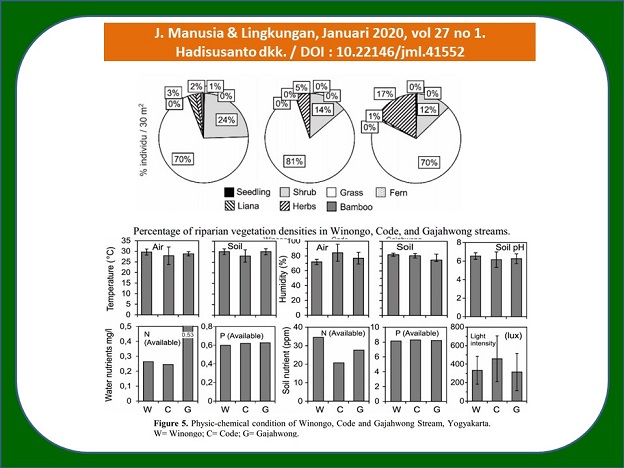
INFLUENCE OF NITRATE AND PHOSPHATE ON THE DISTRIBUTION AND ABUNDANCE OF RIPARIAN VEGETATION IN YOGYAKARTA CITY (Pengaruh Nitrat dan Fosfat pada Distribusi dan Kelimpahan Vegetasi Riparian Kota Yogyakarta)
Suwarno Hadisusanto(1*), Dwinda Mariska Putri(2), Raditia Nugraha(3), Muhammad Rifqi(4), Qisti Fauziyah(5), Riska Putri Asmawati(6), Annisa Mawarni(7), Firda Nabila Nur Azizah(8), Dinda Ayu Islami(9), Fitria Ratna Pratiwi(10)
(1) Laboratory of Ecology and Conservation, Faculty of Biology, Universitas Gadjah Mada, Sekip Utara Yogyakarta 55281
(2) Laboratory of Ecology and Conservation, Faculty of Biology, Universitas Gadjah Mada, Sekip Utara Yogyakarta 55281
(3) Laboratory of Ecology and Conservation, Faculty of Biology, Universitas Gadjah Mada, Sekip Utara Yogyakarta 55281
(4) Laboratory of Ecology and Conservation, Faculty of Biology, Universitas Gadjah Mada, Sekip Utara Yogyakarta 55281
(5) Laboratory of Ecology and Conservation, Faculty of Biology, Universitas Gadjah Mada, Sekip Utara Yogyakarta 55281
(6) Laboratory of Ecology and Conservation, Faculty of Biology, Universitas Gadjah Mada, Sekip Utara Yogyakarta 55281
(7) Laboratory of Ecology and Conservation, Faculty of Biology, Universitas Gadjah Mada, Sekip Utara Yogyakarta 55281
(8) Laboratory of Ecology and Conservation, Faculty of Biology, Universitas Gadjah Mada, Sekip Utara Yogyakarta 55281
(9) Laboratory of Ecology and Conservation, Faculty of Biology, Universitas Gadjah Mada, Sekip Utara Yogyakarta 55281
(10) Laboratory of Ecology and Conservation, Faculty of Biology, Universitas Gadjah Mada, Sekip Utara Yogyakarta 55281
(*) Corresponding Author
Abstract
Abstrak
City of Yogyakarta has three major streams, they are Winongo, Code and Gajahwong. These urban stream accept high input of nutrients throughout the year. Nutrients are in form of organic and non organic matters originated from domestic waste, factory waste, and hospital waste. Riparian vegetation directly respond to stream ecosystem changes. This research aim to learn distribution and abundance of riparian vegetation in Winongo, Code, and Gajahwong, number of species presence in each sampling site, physic-chemical parameters including air and soil temperatures, air and soil humidity, soil pH, light intensity, and NO3- and PO43- in water and riparian soil. In each station, samples were taken using 2x0.5 m plot with 10 replications in floodplain. There are three stations in each stream. Data collected was species number and names. Growth-form grass dominated in all stations. In Winongo the grass density are 1582 ind/10m2 (70%), Code 1697 ind/10m2 (81%) and Gajahwong 1432 ind/10m2 (70%). The most abundant grass were Paspalum sp. in Winongo they were 764 ind/10m2 and in Gajahwong 1103 ind/10m2. While Code was dominated by Panicum sp. they were 735 ind/10m2. Grass were quickly respond to high nutrient availability. High concentration of NO3- and PO43- trigger grass domination. Grass were known for their nutrient fixing behavior, therefore when Grass were most abundant, nutrient concentration decreased in each sampling station.
Abstract
Kota Yogyakarta memiliki tiga sungai utama, yaitu sungai Winongo, Code dan Gajahwong. Sungai perkotaan ini membawa nutrien yang tinggi sepanjang tahun. Nutrien berupa bahan organik dan non organik ini berasal dari limbah domestik, limbah pabrik, dan limbah rumah sakit. Vegetasi riparian secara langsung merespon perubahan ekosistem sungai. Penelitian ini bertujuan untuk mempelajari sebaran dan kelimpahan vegetasi riparian di sungai Winongo, Code, dan Gajahwong, jumlah keberadaan spesies di setiap lokasi pengambilan sampel, parameter fisika-kimiawi meliputi suhu udara dan tanah, kelembaban udara dan tanah, pH tanah, intensitas cahaya, dan kadar NO3- dan PO43- di air dan tanah riparian. Di setiap stasiun diambil sampel dengan menggunakan plot 2x0,5 m dengan 10 ulangan di dataran banjir. Ada tiga stasiun di setiap aliran. Data yang dikumpulkan adalah nomor dan nama spesies. Rerumputan berbentuk tumbuh mendominasi di semua stasiun. Di Winongo kerapatan rumput adalah 1582 ind / 10m2 (70%), Code 1697 ind / 10m2 (81%) dan Gajahwong 1432 ind / 10m2 (70%). Rerumputan yang paling melimpah adalah Paspalum sp. di Winongo seluas 764 ind / 10m2 dan di Gajahwong 1103 ind / 10m2. Sedangkan Code didominasi oleh Panicum sp. mereka 735 ind / 10m2. Rerumputan dengan cepat merespon ketersediaan hara yang tinggi. Konsentrasi NO3- dan PO43- yang tinggi memicu dominasi rumput. Rerumputan dikenal karena perilaku pengikat hara, oleh karena itu pada saat rumput paling melimpah, konsentrasi hara menurun di setiap stasiun pengambilan sampel.
Keywords
Full Text:
PDFReferences
Allan, J. D. 2004. Landscapes and Riverscapes: The Influence of Land Use on Streams Ecosystem. Ann. Rev. Ecol. Evol. Sys 35: 257-284.
Backer, C. A. 1973. Atlas of 220 Weeds of Sugar Cane Fields in Java. Indonesian - Sugar Eksperiment Station. Pasuruan.
Behren, C., A. Dietrich, and J. A. Yeakley. 2013. Riparian Vegetation Assemblages and Associated Landscape Factors Across An Urbanizing Metropolitan Area. Ecoscience 20(4): 373-382.
Burton, M. L., and L. J. Sammuelson. 2008. Influence of Urbanization on Riparian Forest Diversity and Structure in the Georgia Piedmont, US. Plant Ecology 195: 99-115.
Clement, F., J. Ruiz, M. A. Rodriguez, D. Blais, and S. Campeau. 2017. Landscape Diversity and Forest Edge Density Regulate Stream Water Quality in Agricultural Catchments. Ecological indicators 72: 627-639.
Connolly, N. M., R. G., Pearson, and B. A. Pearson, 2016. Riparian Vegetation and Sediment Gradients Determine Invertebrate Diversity In Streams Draining An Agricultural Landscape. Agriculture, Ecosystems and Environment 221: 163-173.
Haycock, N. E., and G. Pinay. 1993. Groundwater Nitrate Dynamics in Grass and Poplar Vegetated Riparian Buffer Strips During The Winter. Journal of Environmental Quality 22 (2): 273-278.
Harding, J.S., K. Claassen, and N. Evers. 2006. Can Forest Fragments Reset Physical and Water Quality Conditions in Agricultural Catchments and Act As Refugia For Forest Stream Invertebrates. Hydrobiologia 568: 391-402.
Gregory, S. V., F. J. Swanson, W. Arthur, and K. W. Cummins. 1991. An Ecosystem Presprective of Riparian Zones. BioScience 41(8):540-551.
Sabater, F., A. Butturini, E. Mart, I. Munoz, A. Romani, J. Wray, and S. Sabater. 2000. Effects of Riparian Vegetation Removal on Nutrient Retention in A Mediterranian Stream. J. N. Am. Benthol. Soc 19(4): 609-620.
Steenis, C. G. G. J. 2006. Flora Pegunungan Jawa. LIPI. Bogor.
Article Metrics
Refbacks
- There are currently no refbacks.
Copyright (c) 2020 Jurnal Manusia dan Lingkungan

This work is licensed under a Creative Commons Attribution-ShareAlike 4.0 International License.







